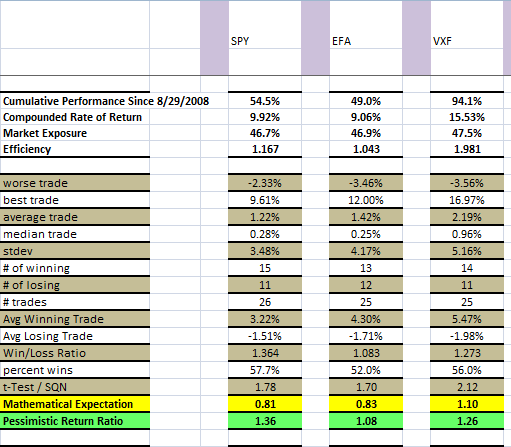.
With the close of markets on Tuesday, April 2nd, my models have confirmed a move to cash. For the TSP folks, this means a 100% shift to the G-Fund.
I am already in cash, having done so prior to my departure on vacation on March 22nd. Little was lost between March 22 and April 2nd close, with the C-Fund increasing +0.9%, the S-Fund decreasing -0.5%, and the I-Fund decreasing -0.4%. It is entirely possible that we could whipsaw from here and move long, especially with the new earnings season starting, but my crystal ball is as good as yours so I'm sitting in cash.
Changes made to your account prior to 12 pm ET will be effective today. Futures are mixed as I write this, shortly before the open of markets, so it is anybody's guess at what will occur today.
I will post the statistics of the latest signal later this week. Going into the open on 4/3, without the close information for today (changes today will post tonight), here are our statistics using this system:
Use of 1x ETFs (SPY = C-Fund, EFA = I-Fund, and VXF = S-Fund), has produced the following results, again with next-day implementation of trades (e.g., use the price of the close the FOLLOWING day, not the closing prices of the day of the signal):
Note that the columns are shifted for EFA/I-Fund and VXF/S-Fund -- it's a pain in the rear for me move these around on my spreadsheet because they are linked in a relative sense to other fields throughout my timer calculations. Note too that I am not using AGG as the proxy for the F-Fund -- I do not commit monies to AGG for my equity accounts.
Key things to compare are the Compounded Rate of Return, Average Winning Trades, Average Losing Trades, and the ME/PRR values. All are comparable, as you would expect.
The lesson here is that you can use the SPY, EFA, and VXF successfully to mirror the performance of your TSP funds. If you are pleased with your TSP, this gives you another avenue with your non-TSP monies.
Regards,
pgd










